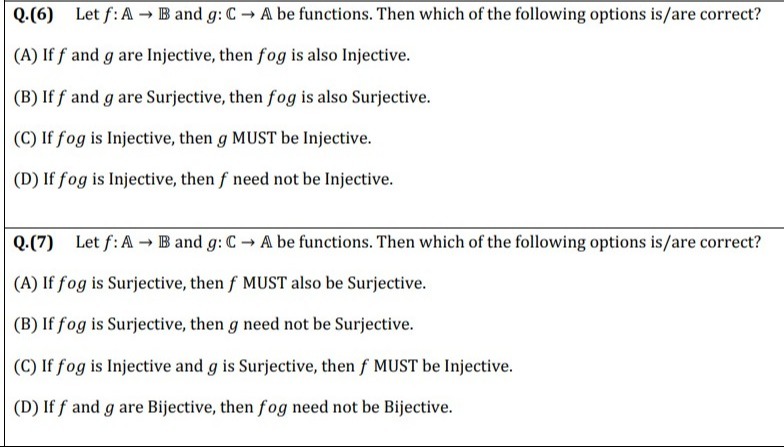Question
Question: Let $f: A \rightarrow B$ and $g: C \rightarrow A$ be functions. Then which of the following options ...
Let f:A→B and g:C→A be functions. Then which of the following options is/are correct?

A
If f and g are Injective, then f∘g is also Injective.
B
If f and g are Surjective, then f∘g is also Surjective.
C
If f∘g is Injective, then g MUST be Injective.
D
If f∘g is Injective, then f need not be Injective.
Answer
(A), (B), (C), (D)
Explanation
Solution
- (A) If f and g are Injective, then f∘g is also Injective.
Let x1,x2∈C such that (f∘g)(x1)=(f∘g)(x2). This means f(g(x1))=f(g(x2)). Since f is injective, g(x1)=g(x2). Since g is injective, x1=x2. Thus, f∘g is injective.
* (B) If f and g are Surjective, then f∘g is also Surjective.
Let y∈B. Since f is surjective, there exists a∈A such that f(a)=y. Since g is surjective, there exists c∈C such that g(c)=a. Then (f∘g)(c)=f(g(c))=f(a)=y. Thus, f∘g is surjective.
* (C) If f∘g is Injective, then g MUST be Injective.
Let x1,x2∈C such that g(x1)=g(x2). Applying f to both sides, f(g(x1))=f(g(x2)), which means (f∘g)(x1)=(f∘g)(x2). Since f∘g is injective, x1=x2. Therefore, g is injective.
* (D) If f∘g is Injective, then f need not be Injective.
Counterexample: Let A={1,2}, B={3}, C={4}. Define f(1)=3,f(2)=3 (not injective). Define g(4)=1. Then (f∘g)(4)=f(g(4))=f(1)=3. The function f∘g has a singleton domain, so it is injective, while f is not.
